Manufacturing Execution Systems (MES) allow you to precisely plan all your manfacturing workflows, to monitor them in real time and to systematically optimize them. And why? Because the “classic” factory has long ceased to exist and has instead evolved into a high-tech service center. This development requires new production management concepts which allow you to react to production changes quickly and flexibly.
At the same time, it is important to continuously work on optimizing the production processes with a view to achieving economic efficiency. The aim is to avoid defects during the process sequence as well as waste and bottlenecks. Many companies already use an Enterprise Resource Planning system (ERP) to plan all their higher-level processes and workflows. However, a special MES system, as described above – also known as an operations control system, goes one step further down the road to Industry 4.0 by helping you to realize an effective, automated planning system.
Have you already acquired plenty of information on the topic of MES and are now looking for a suitable MES system? Then you have arrived at exactly the right place – our webpage on our MES software.
- What is a Manufacturing Execution System?
- Standards and guidelines applying to MES systems
- OPC UA – standardized data exchange for industry 4.0
- What tasks does an MES have?
- Indicators for monitoring production
- How does MES interact with your ERP system?
- Which are the best MES systems?
- How does working with an MES system actually work?
- Using MES to plan your production processes
- Using your Manufacturing Execution System during production
- Management processes based on MES
WHAT IS A MANUFACTURING EXECUTION SYSTEM?
MES stands for Manufacturing Execution System. MES systems are used in the operational production management area. MES systems support all the tasks connected with planning and controlling your production processes. The software allows you to monitor your production process in real time, thanks to the direct link between your production process and your MES system. This involves importing all the relevant production data through the following processes:Production data acquisition – for manually returning information from your machines and order details
- Machine data collection – for an automated import of machine data
- Personnel data acquisition – for controlling your human resource planning
- Quality data acquisition – for integrated quality management
- and process data collection, for monitoring important process parameters.
MES uses all of this information to provide a digital screenshot of where your production currently stands: Production events become immediately evident – with planning errors and optimization potential exposed.
Your MES program is the interface between your existing ERP system and your process automation systems. Due to being positioned right here, your MES Manufacturing Execution System ensures, on the one hand, that the huge amount of data from your production processes is assimilated to provide transparent information. On the other hand, MES also controls the execution of your current detailed planning whilst taking into account the feedback received from your production processes.
STANDARDS AND GUIDELINES APPLYING TO MES SYSTEMS
VDI Guideline 5600 provides a basis for designing the content of an MES system. This includes a standardized definition of which tasks an MES should be able to perform and the significance of the MES system for each respective process step.
VDMA Specification No. 66412 also defines the indicators used by the production management system to monitor the set targets for the individual production processes.
OPC UA – STANDARDIZED DATA EXCHANGE FOR INDUSTRY 4.0
To achieve a fast and uniform exchange of data, Böhme & Weihs relies on the globally accepted communication standard OPC UA.
OPC UA stands for Open Platform Communications Unified Architecture. OPC UA ensures smooth communications between machines produced by different manufacturers and your MES system – or even other systems – within the company. OPC UA is, so to speak, the interpreter who first translates outgoing machine process data, such as temperatures, pressures, number of revolutions, number of units, utilization, into a uniform standard and then makes these available to other systems.
OPC UA also works the other way around – handling the transmission of the MES specifications to the machines. This makes it considerably easier for a company to implement the requirements of Industry 4.0. The OPC UA technology not only offers the advantage of a uniform communication standard but also guarantees secure data transmission through authentication certificates, encrypted transmissions and a special rights system. To transport the data, OPC UA uses established data protocols, such as a TCP-based binary protocol for high-performance applications or HTTP/HTTPS web service.
WHAT TASKS DOES AN MES HAVE?
The main functions that a Manufacturing Execution System should be able to fulfill are:
- Order management – for splitting orders into the respective operations and adding up-to-date production information to the order data.
- Detailed planning – for distributing the orders to the machines according to your production targets and process workflows.
- Operating resource management – for ensuring the technical functionality and availability of your plant and machinery.
- Human resource management – for scheduling your production personnel whilst taking into account their qualifications and availability.
- Data acquisition – for the event-controlled acquisition of production-relevant data, such as machine data (MDC), production data (PDA), process data, quality data and personnel data.
- Production monitoring – for monitoring your production in real time: How far has each order progressed? Which machines are at a standstill? Where do bottlenecks arise?
- Quality management – for guaranteeing the quality of your products and processes right from the outset.
- Performance analysis – for a comprehensive evaluation of your production system using specific production indicators.
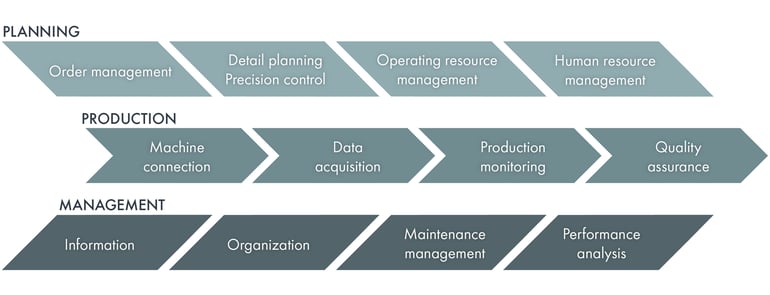
INDICATORS FOR MONITORING PRODUCTION
MES consolidates the production data in a series of Key Performance Indicators (KPI). These include both workplace and machine-related indicators, as well as comprehensive indicators for evaluating the organization of the production processes. These KPIs allow the progress and to what degree the production targets have been fulfilled, as well as critical success factors, to be transparently evaluated.
For example, you can see whether there are any waiting times that would generally allow faster through-times – and whether resources are being optimally used. This allows you to improve your company’s reaction times and your ability to adhere to delivery deadlines, as well as your overall efficiency – which, after all, ultimately improves your competitiveness.
These indicators include the following:
- Lead times
- Adherence to delivery deadlines , for example, by an individual workstation
- Machine utilization, aimed at evaluating spare capacity
- Machine efficiency
- Reject rates
- Process efficiency (OEE – Overall Equipment Effectiveness)
HOW DOES MES INTERACT WITH YOUR ERP SYSTEM?
In a process workflow, your ERP system kicks in in advance of your MES system. This is because an MES system is generally based on the information from your ERP system. This includes order data, such as the type and quantity, as well as logistical details, such as material availability. ERP uses this information to provide a rough plan. This means that although orders are assigned to shifts, they are not assigned to precise production times. Likewise, groups of machines are accordingly assigned but not specific individual machines. The allocation of specific resources is done in the second step – during the so-called detailed planning stage.
Some ERP systems are capable of supporting the detailed planning phase. They can split orders into operations, assign machines and personnel and schedule these for an exact time in the production process. However, last-minute production events, such as a shortage of personnel, machine downtime or broken tools, are not accounted for. This is where MES solutions have a clear advantage – through monitoring the production process in real time.
MES handles the detailed planning based on your ERP information. The order in which the orders are processed, and the specific workflows involved are determined by the control center. The required resources, such as machines and appropriately qualified employees, are assigned to each individual operation, whereby this is permanently compared with the actual production situation in order to be able to directly incorporate any relevant events into the respective plans. This provides you with a detailed deployment plan for all your personnel, machines, tools and materials. In turn, important data from this online monitoring system and the evaluation of your production processes is fed back into your ERP system.
This creates a feedback control system in which two systems for collecting information and optimizing processes are optimally integrated.
There is a huge range of MES software available. The first selection criteria to consider when searching for a suitable MES system provider are the desired scope of service and the environment in which MES is to be implemented. For example, is an English user interface required? Or is the network capability of your MES system of importance with regard to Industry 4.0? The focus here is on the interaction between MES and CAQ. Quality and production management software solutions do not only include content that links up but are also described in the standards and guidelines, such as VDI Guideline 5600, as being strongly connected.
In such cases, the recommendation is to go with those MES system providers who provide both modules from a single source – partners who offer integrated solutions. Such integrated solutions avoid redundancies when acquiring and evaluating data. When setup to interact, MES and CAQ provide an integrated overview and analysis of your process and production quality. Additionally, this offers your employees a consistent and, thus, familiar user interface. Last but not least, sourcing CAQ and MES from a single source also means considerable cost savings due to the fact that there is no need to invest additional effort in networking the two systems, for example, via an individual interface.
In general, we recommend considering the following criteria:
- Standardized: If the standards, such as the respective VDI guideline and VDMA specification , are complied with, this will ensure that your MES system will be able to cope with the requirements placed on it when you implement it as your production management system. This also includes the use of standardized technologies, such as OPC UA , for standardized machine communications.
- Web-based: The MES system can be flexibly operated from different terminal devices and locations due to being accessible via a web browser.
- Cloud-based: A cloud-capable system offers you the option of adding any machine at any plant anywhere around the globe to your network – an important step towards implementing Industry 4.0.
- Highly transparent: Data acquisition and processing should be done in a matter of seconds – providing you with a true, real-time screenshot of your production steps.
- Intuitive: Intuitive and simple operability ensures short training periods, acceptance by your employees and the ability to gain information fast during your everyday production processes.
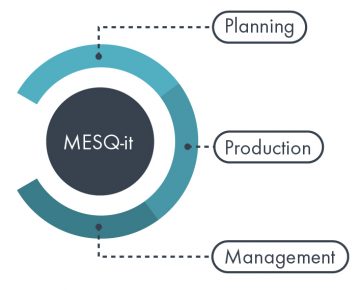
An MES Manufacturing Execution System supports you in identifying weak points and unexploited potential based on indicators and analysis. The superior goal is to achieve consistent efficiency within your production process which will ultimately lead to cost savings for your company. An MES system will support you throughout all the phases that you generally have to go through when handling or looking at a production process:
- Planning
- Controlling
- Management
USING MES TO PLAN YOUR PRODUCTION PROCESSES

Böhme & Weihs is the provider of the WEB.MES Manufacturing Execution System software and as such offers an integrated system with a range of different functional areas. Our MES functions support you in planning your production processes and offer the best possible level of transparency with regard to optimization potential. These functions include:
- Integrated order management
- Precise detailed planning software
- Reliable operating resource management
- Targeted human resource planning
OUR INTEGRATED ORDER MANAGEMENT MODULE
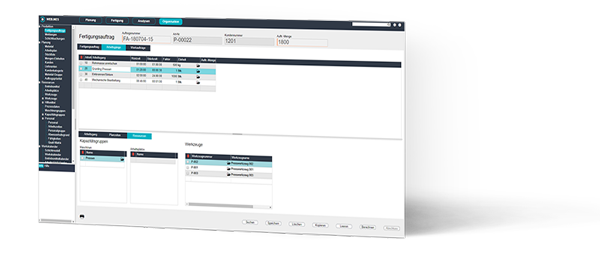
WEB.MES helps you to manage your orders through its integrated order management feature. This takes not only your production jobs into consideration but also all your maintenance, servicing and repair jobs. The number of orders in the pool can flexibly adapt to changing conditions – including adjustments to your production targets, changes to your orders and high-priority rush jobs. You can keep an eye on where your order currently stands so as to be able to react to any disruptions that occur as quickly as possible.
OUR PRECISE DETAILED PLANNING SOFTWARE
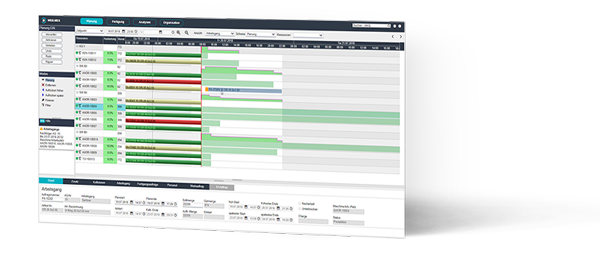
Our detailed planning software helps you to work out an ideal deployment and machine utilization plan. In the control center, your orders can either be manually distributed or assigned automatically according to your production targets. Through a digital planning chart, MES provides you with a precise overview of all your current and planned orders as well as your personnel, tooling and machine assignments – and also includes a simulation feature to solve planning conflicts.
AVAILABILITY AND FUNCTIONAL CAPACITY OF YOUR OPERATING RESOURCES
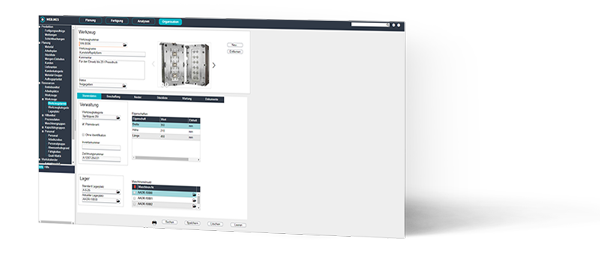
Our operating resource management tool ensures the availability of your plant and machinery and lets you plan your maintenance and repair jobs efficiently. You can also use WEB.MES to directly assign the required work steps to specialized personnel. Our MES software compiles all the relevant information in a clearly structured summary. In addition, a long-term archive allows you to track all the events associated with each individual operating resource.
TARGETED HUMAN RESOURCE PLANNING
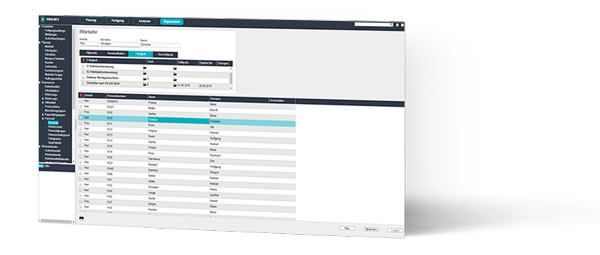
The human resources in your production division can also be managed by WEB.MES. The presence or absence of employees, shift models, qualifications and short-term changes in requirements are all incorporated into the planning process. The integrated human resource plan and shift schedule visualize free capacity which can be used to further optimize the processing of the order pool.
USING YOUR MANUFACTURING EXECUTION SYSTEM DURING PRODUCTION

WEB.MES provides you with a comprehensive overview of your entire production process. This is based on the data collected on your employees via PDA, as well as automatic machine data collection. This information is then prepared for your shop floor management in the production cockpit. Production backlogs, bottlenecks, the respective degree of processing and lead times are displayed in real time. When used in combination with a CAQ system designed to control and monitor your quality levels, your MES system becomes a decisive management tool.
- Efficient machine data collection (MDC)
- Precise production data acquisition (PDA)
- Transparent production monitoring
- Quality assurance for all your business processes – realized through CAQ
EFFICIENT MACHINE DATA COLLECTION
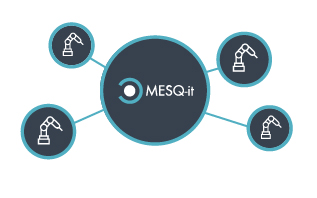
WEB.MES ensures that you are able to monitor your machinery in real time through its machine data collection function. Machine states and order progress are detected and automatically returned to your MES system – resulting in a precise machine monitoring system, including detailed production indicators. An integrated alarm system calls your attention to any problem machines so that you can immediately react to any unscheduled events.
ACCURATE PRODUCTION DATA ACQUISITION
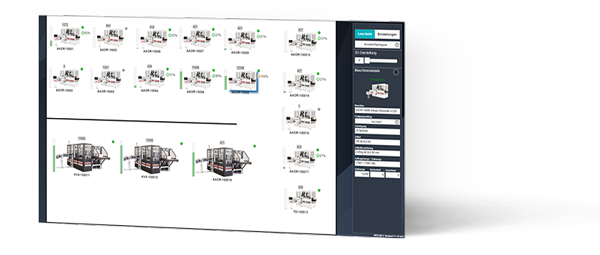
The PDA software (PDA) installed on group and individual terminals provides your employees with optimal support during the production process. The online hall plan provides your machine operators with a snapshot of the production process, including the machine status and order details. At the same time, your employees can easily record all the information returned from the production process via their terminals, including orders entering or leaving the order processing chain. Plausibility checks warn you of any incorrect entries, providing you with true and dependable production monitoring results.
TRANSPARENT PRODUCTION MONITORING
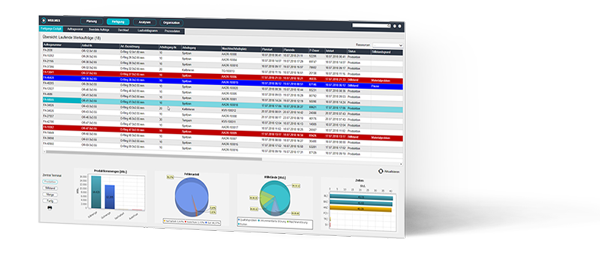
At the heart of any MES system is its powerful ability to monitor all the steps throughout your entire production process in real time. Through WEB.MES, you can control your production process in a targeted manner – enabling you to immediately react to any machine downtimes, time delays or exceptionally high reject rates. The great advantage of monitoring production using WEB.MES is that it allows you to flexibly retrieve information as it can also be displayed on your tablet PC or smartphone via the Web.
CAQ SOFTWARE

Our CAQ system incorporates all the relevant processes into your quality assurance system along the whole value chain. The big advantage of Böhme & Weihs’ CASQ-it software is its process-oriented mode of operation. CASQ-it can be flexibly integrated into your workflows – stating with the development process and finishing with your materials process – and covering all the other support processes. Thanks to its modular design, CASQ-it offers the perfect solution for any size of company – and can meet any requirement.
MANAGEMENT PROCESSES BASED ON MES

In addition to monitoring operational implementation, an MES system also supports management efforts aimed at sustainably improving the production process and ensuring optimum utilization in the long term. WEB.MES includes four special functional areas to support your management processes in the production section:
- Targeted qualification management
- Preventive maintenance
- Interactive performance analysis
- Transparent booking history
TARGETED QUALIFICATION MANAGEMENT
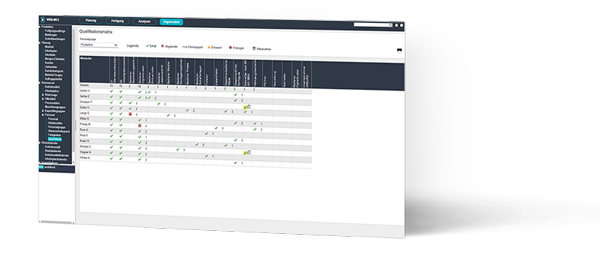
Our qualification management software provides the basis for aligning advanced employee training measures to future needs whilst simultaneously increasing motivation levels through the promotion of new skills. Our qualification matrix displays the skills of all your employees – allowing improvement potential to be systematically identified. Our schedule overview and reminder service let you keep an eye on which training measures are due.
PREVENTIVE MAINTENANCE VIA MES
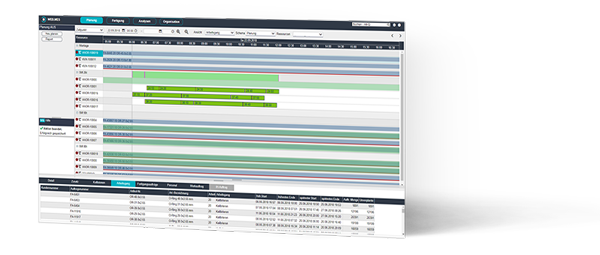
Maintenance is an essential factor in ensuring the performance and availability of your machine park. This is why Böhme & Weihs’ MES system is designed to support your Total Productive Maintenance strategy. The maintenance, servicing and repair intervals are automatically monitored. All your maintenance tasks are planned in a graphical overview. Your MES system notifies you of any pending tasks well in advance and automatically makes allowance for maintenance times when completing the detailed planning for the order pool.
INTERACTIVE PERFORMANCE ANALYSIS
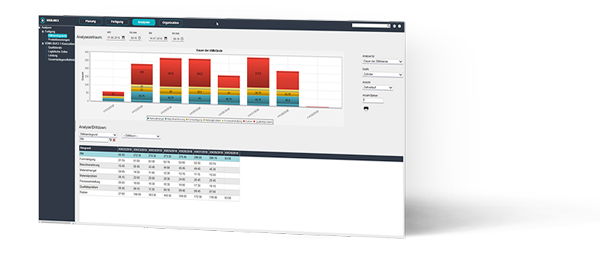
The Key Performance Indicators incorporated in our WEB.MES software help you to detect improvement potential in your production process and to optimally exploit this accordingly. To achieve this, WEB.MES calculates the respective production and process-relevant indicators according to VDMA Specification No. 66412 (including OEE, reject rates, quality levels and set-up status) and compares these with the planned targets. Drill-down capable analysis and target/actual comparisons ensure that all the processes are comprehensively evaluated.
WEB.MES’ TRANSPARENT BOOKING HISTORY
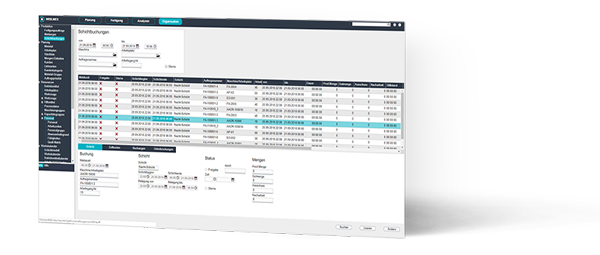
By archiving all the messages received from your machines, WEB.MES provides an informative log of all your production processes. This means that it is always possible to trace what happened to which operating resource – and when. WEB.MES provides an overview of all the disruptions, including their causes and related downtimes, on a daily basis and according to the exact shifts. This means that all the events can also be accessed in arrears. Combined with our real-time monitoring feature and our long-term performance analysis tool, this function provides you with a complete overview of your machine park.

